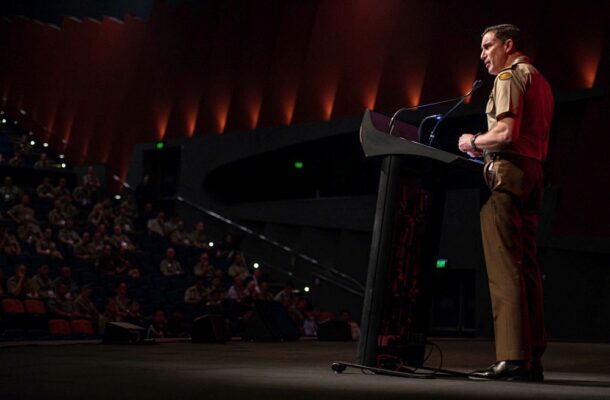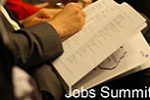On 29 and 30 August, Perth played host to the annual Chief of Army Symposium. This year’s edition focused on the innovation and partnerships—with industry, entrepreneurs, end users and investors—necessary to continue to enable an adaptive Australian Army.
The media, commentariat and academia eagerly anticipate the service chiefs’ keynotes at these events. Meanwhile, the army’s rank and file want to hear directly from their leader on service priorities.
In a joint and integrated force, service priorities can’t be separated from the broader efforts of the Australian Defence Force, the civilian and contracted defence workforce, or the entrepreneurs and established industry players that must come together to deliver the defence leadership’s direction. And so the sea of green was appropriately punctuated with blue, grey, white and civvies.
In a speech that didn’t disappoint, Lieutenant General Simon Stuart offered a clear message to a large in-person and online crowd: Technology alone can’t win wars; it is a fundamentally human endeavour. And while the character of war may be ever changing, its nature is enduring. This message balances the narrative of technological primacy in modern conflict environments.
In the competition for strategic advantage, it’s enticing to think that the unprecedented speed of technological development can turn longstanding realities of war on their head.
Sure, the ability to understand the opportunities and risks of new and emerging technologies, and to put the best tech in the hands of warfighters quickly and responsibly, will provide an edge that modern militaries have long sought to exploit to create advantage.
But Stuart unquestionably focused on people as the differentiator in the Australian Army.
That’s a simple but powerful idea, and most consequentially it provides the necessary organising principle for strategy and planning across the army’s functions. It is a strong core for conceptual coherence.
The Australian Army focuses on adapting new technology to warfighting requirements and tactics in four main areas: robotics and automated systems, artificial intelligence and machine learning, quantum computing, and human performance optimisation. As Stuart sees it, the combined application of these technologies is most likely to provide human advantage and enhance the utility of land power on future battlefields.
Land forces are uniquely positioned to leverage presence, persistence, distributed international networks and asymmetry in a potential contingency. Australia’s land forces are the largest and typically the least capitalised of the services and are therefore capable of delivering exceptional versatility and value for money. It’s the fighting force that presents the human face of war most tangibly across the spectrum of peacetime to wartime activities.
Stuart said he expects the army to leverage its capacity for innovation and intellectual wherewithal to identify the most appropriate innovations in emerging concepts so that it can fully exploit the technological developments that are occurring now.
But he reminded members to undertake that task anchored in the history. The ADF’s experiences during Operation Postern in 1943 should guide the integration of technology for operations in our littoral to preserve the human in the loop and minimise trading blood in the first contact. Stuart later echoed those sentiments at the Chief of Army History Conference held in Canberra this week, saying that the army has in its DNA the ability to develop sound doctrine and robust land tactics while in conflict, as the 1943 Lae landing in New Guinea aptly demonstrated.
Adapting the army for the future fight means seeking avenues to offload risk to technology where it is both possible and advantageous to do so, Stuart said. Merging the art and science of warfare by freeing up human capacity to apply lethal force and leveraging human–machine learning to generate mass, enhance force protection capabilities and improve manoeuvrability will unlock the full potential of technology as a significant force multiplier.
Stuart reiterated that while the transformation the army is undertaking isn’t new, changing the way it operates to meet the challenges in Australia’s strategic environment requires new thinking and difficult decisions.
Plan Beersheba, the modernisation strategy that came into effect in 2011 prioritised a balanced force that wasn’t optimised for any specific mission. Key changes to the army’s structure and posture today are focused on generating combat capabilities that are optimised for deterrence, extended strike and joint littoral operations. Under the latest restructure, the army is delivering on an ‘intellectual pivot’ that’s informed by an appreciation of history and seeks to build advantage through a people-first approach.
Beginning in 2025, a staged relocation process will see around 800 troops moved from Adelaide to Brisbane, Townsville and Darwin as armoured vehicles and full-time infantry are withdrawn from the South Australian capital. There are significant challenges to this move, and it will require strong planning and development of these northern locations to support the army’s critical hardware and capability along with its people.
The government has made it clear that the northern movement of forces will occur within the normal posting cycles to limit its human impact and that support will be extended to army personnel and family members as the changes are implemented. Nonetheless, the move is complex and relocating core army capabilities that have resided in the south for decades is a huge task.
It’s tempting to lament the fact that Australia’s defence strategy has resulted in such a dramatic restructuring of our land forces and posture. But even amid current recruiting issues, we should commend the army’s efforts to pair the best minds with the best technology. The 2023 defence strategic review’s focus on innovation and technology allows the army to continue its efforts to deliver outsized benefits and outcomes from its investments.
Importantly, Stuart clearly stated that his people remain at the centre of his conception of future army capability. This is the right approach to deliver on the obligation to ensure our warfighters have what they need to fight and win and come home. And it will help get the army through some challenging times ahead.














